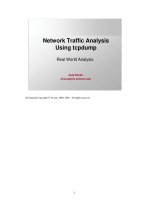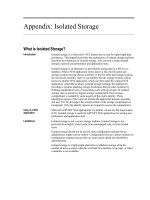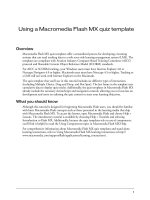Tài liệu Retrofitting your Raceways docx
Bạn đang xem bản rút gọn của tài liệu. Xem và tải ngay bản đầy đủ của tài liệu tại đây (155.69 KB, 4 trang )
WHITE PAPER
Retrofitting your Raceways
for Additional Optical Fiber
Retrofitting your Raceways
for Additional Optical Fiber
The amount of fiber used in today’s central office facilities challenges service
providers with fiber management issues. In many cases, raceways were
installed to accommodate the immediate needs without a plan for future
growth. These undersized raceways are now unable to adequately support the
enormous amounts of fiber required for today’s telecom network systems.
A typical switch room today consists of 12-inch raceways in the main aisles
with six-inch raceways used for intermediate line-ups. As more fiber is added,
pile-ups occur – sometimes as deep as four inches or more. The Telcordia
standard (GR-449) states the cable buildup of fiber jumpers should never
exceed two inches in depth at any point within the fiber protection system.
This paper will address the issues regarding fiber buildup in raceways and
provide retrofitting solutions that can alleviate potential problems resulting
from too much fiber in too little space.
Motivation to retrofit
The fiber running directly over the fiber distribution frames is typically where
raceway retrofitting is most necessary. As fiber counts increase, more patch
cords are running across these raceways, increasing the need for a higher
capacity infrastructure. For example, a five-frame
line-up might require 1,000 patch cords per frame,
so capacity would be needed to accommodate 5,000
patch cords overhead. This may seem like simple
math, but the simple truth is that either service
providers don’t believe they will ever need five full
frames of fiber, or they somehow misjudge the size of
the raceway for accommodating growth in the fiber.
Service providers often base raceway size on their
"day one" requirement of one frame, hoping they will
have enough space for growth in the raceway and
save on initial costs. In reality, not planning for long-
term growth becomes more expensive when the need
arises for retrofitting raceways down the road. This is
where many service providers are finding themselves
today – with a need to retrofit their fiber raceways.
Here are some systems and techniques for performing
the retrofit without taking fibers out of service.
Page 3
Retrofit techniques
There are several different methods used to retrofit
a raceway system to accommodate more fiber. One
method is to use four-inch by eight-inch fiber paper
to wrap the fibers together, and then pull them up
from the existing raceway with regular lacing cord.
(See Figure 1) This holds them above the raceways
with as little stress as possible to the fibers as the
raceway is replaced underneath. This method should
typically be used where fibers are not exceeding the
limits of the existing raceway by much and are easily
bundled together.
In cases where there is an inch or more of excess fiber
piled in the raceway, another method may be more
practical. With the slide-in, slide-out method, 24-inch
raceway is installed beneath the existing 6-inch or
12-inch existing duct. Once in place, the brackets are
removed from the smaller duct and it is slid out from
under the fiber, which comes to rest in the new, larger
raceway. This puts the least amount of stress on the
fiber. Cut-in bracket fittings and expandable straight
sections enable easier raceway reconfiguration during
the retrofit.
Both methods enable the retrofit to occur without
service outages. That said, anytime fiber is handled,
there will always be a risk of damage and circuit
outage. Finding the smoothest and most effective
means of retrofitting is critical. The retrofit can also be
accomplished during maintenance windows and during
slower hours.
Having fiber back-up kits available in case of a fiber cut
is critical. These kits generally include connectors and
fiber to enable rapid repairs, should a fiber be damaged.
Prior to starting the retrofit, it is recommended that
service providers work with their vendor to verify the
longest fiber footage and order the appropriate
back-up kit. This should be a primary consideration
when service providers evaluate vendors to perform
the retrofit procedure.
It’s also worth mentioning that service providers should
insist on quality technicians to perform any raceway
retrofit operation. Typically, this is a task for experienced
level 3 and level 4 technicians. From the operational
standpoint, the retrofit team should be of the highest
technical caliber possible.
Plan, plan, plan
Planning is the key when it comes to initial installation
of fiber raceways. It’s important to not only consider
having the right capacity well into the future, but also
from the standpoint of routing within the raceway.
There should be diverse pathways to minimize choke
points or pile-up points that prevent all the fibers going
through the exact same piece of duct or raceway. For
instance, a fiber frame line-up is more efficient when
fed fiber from both ends of the line-up as opposed to
all the fiber coming from just one end.
Not all retrofits will expand to 24-inch raceway. It
could be an expansion from four-inch to 12-inch duct
or four-inch to six-inch. But planning the raceway
with future growth potential in mind can save time
and expense as the network evolves. Service providers
should make certain they plan for the future in terms
of how many fibers may eventually run over the top of
the distribution frames – carefully considering long-term
capacity requirements.
The demand for fiber circuits is steadily increasing
as bandwidth capacity usage grows in homes and
businesses. A recent example illustrates this point.
One recent raceway retrofit project had the dynamic
growth to fill a 12-inch duct more than four inches
deep in fiber – in less than a six-month period. With this
phenomenal growth, more service providers should be
aware of how much fiber (remember, a maximum two-
inch depth is recommended by Telcordia) is currently in
their raceways, and how much more may be required in
the coming months and years.
Assessing your current fiber counts and planning for
future fiber growth is the first stop in creating your
future-proofed network infrastructure.
Retrofitting your Raceways for Additional Optical Fiber
Figure 1: Fiber Paper Retrofit Technique Shown
WHITE PAPER
Website: www.adc.com
From North America, Call Toll Free: 1-800-366-3891 • Outside of North America: +1-952-938-8080
Fax: +1-952-917-3237 • For a listing of ADC’s global sales office locations, please refer to our website.
ADC Telecommunications, Inc., P.O. Box 1101, Minneapolis, Minnesota USA 55440-1101
Specifications published here are current as of the date of publication of this document. Because we are continuously
improving our products, ADC reserves the right to change specifications without prior notice. At any time, you may
verify product specifications by contacting our headquarters office in Minneapolis. ADC Telecommunications, Inc.
views its patent portfolio as an important corporate asset and vigorously enforces its patents. Products or features
contained herein may be covered by one or more U.S. or foreign patents. An Equal Opportunity Employer
105257AE 9/07 Original © 2007 ADC Telecommunications, Inc. All Rights Reserved
WHITE PAPER









